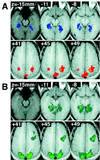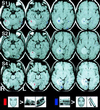Neural components of topographical representation
- PMID: 9448249
- PMCID: PMC33806
- DOI: 10.1073/pnas.95.3.839
Neural components of topographical representation
Abstract
Studies of patients with focal brain damage suggest that topographical representation is subserved by dissociable neural subcomponents. This article offers a condensed review of the literature of "topographical disorientation" and describes several functional MRI studies designed to test hypotheses generated by that review. Three hypotheses are considered: (i) The parahippocampal cortex is critically involved in the acquisition of exocentric spatial information in humans; (ii) separable, posterior, dorsal, and ventral cortical regions subserve the perception and long term representation of position and identity, respectively, of landmarks; and (iii) there is a distinct area of the ventral occipitotemporal cortex that responds maximally to building stimuli and may play a role in the perception of salient landmarks. We conclude with a discussion of the inferential limitations of neuroimaging and lesion studies. It is proposed that combining these two approaches allows for inferences regarding the computational involvement of a neuroanatomical substrate in a given cognitive process although neither method can strictly support this conclusion alone.
Figures





References
-
- O’Keefe J, Nadel L. The Hippocampus as a Cognitive Map. Oxford: Oxford Univ. Press; 1978.
-
- Brewer B, Pears J. In: Spatial Representation. Eilan N, McCarthy R, Brewer B, editors. Oxford: Blackwell; 1993. pp. 25–30.
-
- Heft H. Environ Psychol Nonverbal Behav. 1979;3:172–185.
-
- Thorndyke P W, Hayes R B. Cognit Psychol. 1982;14:560–589. - PubMed
-
- Magliano J P, Cohen R, Allen G L, Rodrigue J R. J Environ Psychol. 1995;15:65–75.
Publication types
MeSH terms
Grants and funding
LinkOut - more resources
Full Text Sources

